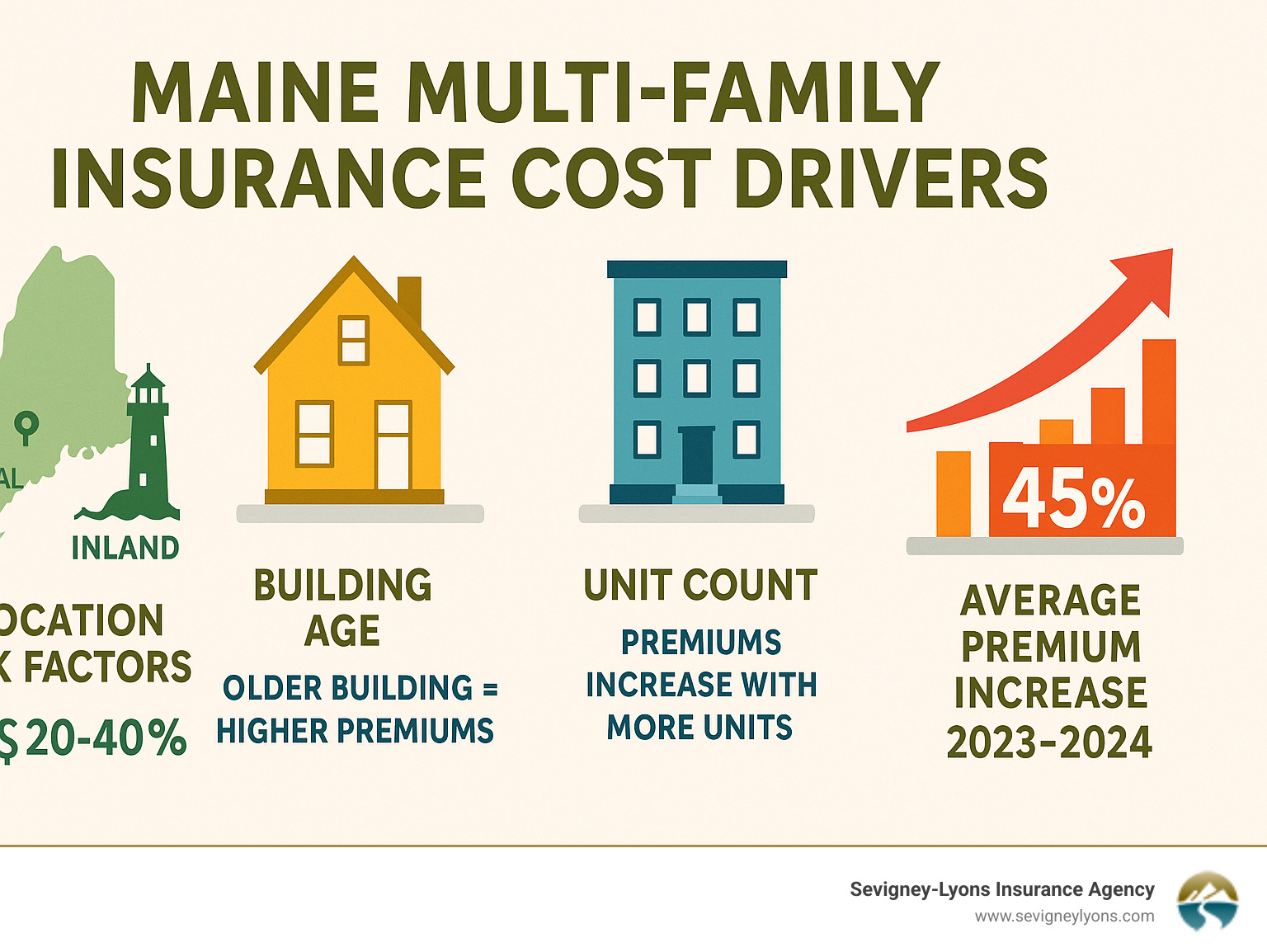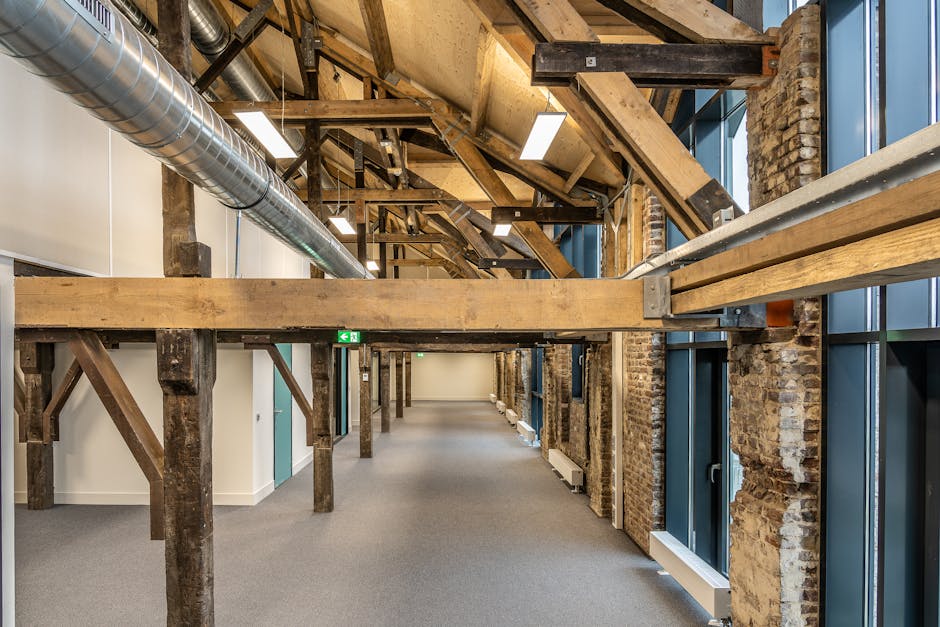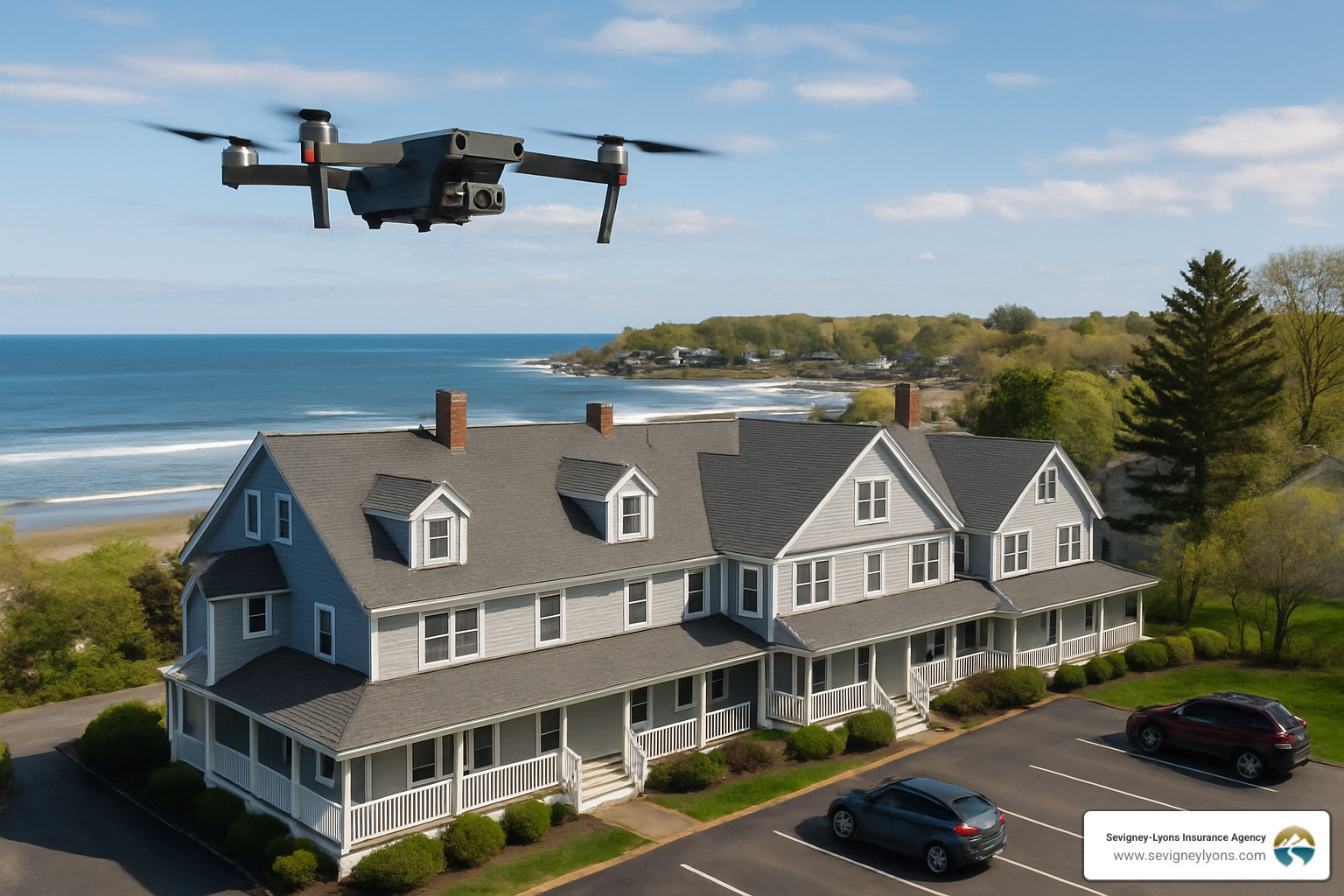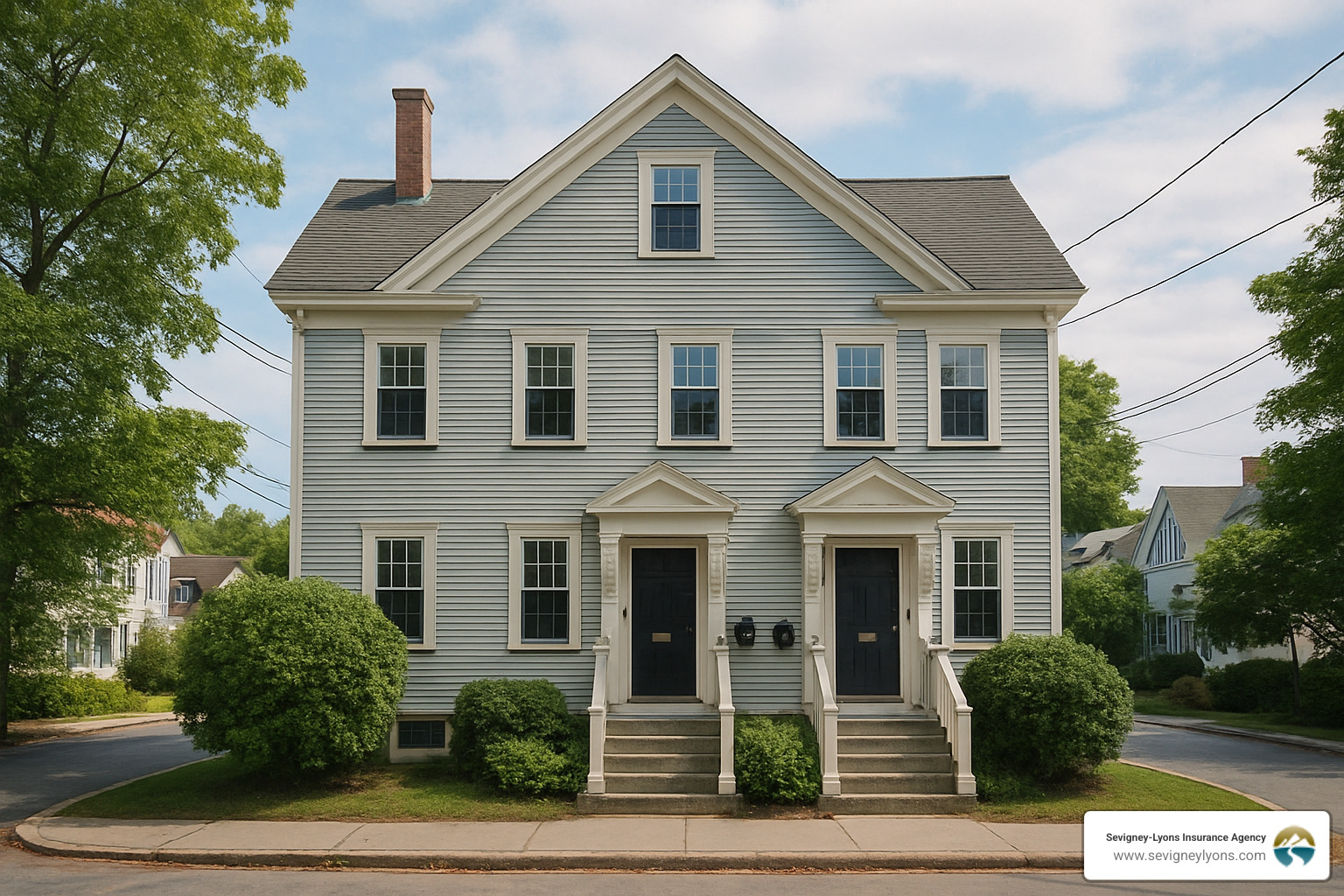Blog Content
Why Multi-Family Property Insurance Matters More Than Ever in Maine
Home insurance for multi-family homes has become one of the most challenging aspects of real estate investing, especially in Maine's coastal communities. Whether you own a duplex in Wells, a converted mill building in Biddeford, or a seaside fourplex in Ogunquit, the stakes have never been higher.
Quick Answer for Maine Multi-Family Home Insurance:
- Coverage Types: Property damage, liability, loss of rental income, equipment breakdown
- Policy Options: HO-3 (owner-occupied), DP-3 (rental), commercial packages (5+ units)
- Average Cost: $200-$600 per unit annually in Maine
- Maine Specifics: Coastal wind, ice dam, flood zone considerations required
- Key Exclusions: Flood, earthquake, tenant belongings, normal wear-and-tear
Multifamily housing owners nationwide reported their annual property insurance premiums increased by an average of 45% from 2023 to 2024 alone. In Maine's coastal markets like Kennebunk and Ogunquit, these increases hit even harder due to storm surge and wind exposure.
From nor'easters that can damage multiple units simultaneously to liability claims involving common areas, multi-family properties face unique exposures that standard homeowners insurance simply won't cover.

Terms related to Home insurance for multi-family homes:
Home insurance for multi-family homes in Maine: The Basics
Home insurance for multi-family homes isn't just regular homeowners insurance with extra units tacked on. When a pipe bursts in your Wells duplex, it becomes two families' emergency, plus your rental income disappears overnight.
The biggest decision you'll face is whether you live in one of your units or rent them all out. Owner-occupied properties where you call one unit home often qualify for modified homeowners policies (HO-3). Investment properties where every unit generates rental income typically need dwelling fire policies (DP-3).
Your coverage needs to protect several key areas: property damage protection, general liability coverage, loss of rental income, and equipment breakdown for shared systems like boilers.
For a deeper dive into Maine's insurance landscape, our Maine Home Insurance Explained guide covers the fundamentals.
Why "home" insurance becomes "commercial" after four units
Insurance companies draw a clear line at four units. Own four units or fewer? You're in "residential" territory. Own five or more? Welcome to commercial insurance land.
Small multi-family properties with 2-4 units have two main paths:
HO-3 homeowners policies work for owner-occupied properties. If you're living in one unit of your Wells duplex while renting out the other, an HO-3 policy covers both your home and your landlord responsibilities.
DP-3 dwelling fire policies serve pure investment properties. When you own that fourplex in Ogunquit but live across town, a DP-3 policy focuses on the building structure and rental income.
Larger properties with 5+ units must enter the commercial insurance world with comprehensive policies that recognize these buildings operate more like businesses than homes.
Key property types that qualify in Wells, Kennebunk, Ogunquit & Biddeford
Duplexes are the bread and butter of multi-family investing in Wells and Kennebunk, often qualifying for residential-style coverage when you live in one unit.
Triplexes and fourplexes dot our coastal communities, many created when larger homes were converted to capture Ogunquit's seasonal rental market.
Converted mill buildings in Biddeford require commercial coverage due to their size and complexity, often needing special provisions for maintaining their historical character.
Mixed-use properties combining street-level retail with apartments above always require commercial coverage because of the business exposure.
Essential Coverages Every Landlord Should Know
As a Maine landlord, your Home insurance for multi-family homes needs to protect against risks that don't exist with single-family properties.
Property damage coverage protects your building structure against fire, lightning, wind, hail, vandalism, and theft, extending to permanently attached fixtures like built-in appliances and plumbing systems.
General liability coverage becomes crucial when multiple families share common spaces. When someone slips on the icy walkway to your Wells duplex, this coverage handles medical bills and legal defense costs.
Loss of rental income coverage steps in when covered damage makes units uninhabitable. When a kitchen fire affects your fourplex, you're losing monthly rental income while contractors rebuild.
Equipment breakdown coverage protects expensive shared systems serving multiple units, like boilers or HVAC systems.
Don't overlook crime coverage for theft protection and sewer backup coverage as Maine's aging systems struggle with heavy spring runoff.
Flood insurance requires a separate policy through the National Flood Insurance Program. Check current Flood Insurance Rate Maps to understand your property's flood zone.
Ordinance or law coverage pays additional costs when rebuilding must meet current building codes - essential for older Maine properties.
Primary coverage menu for Home insurance for multi-family homes
Building coverage protects the physical structure using either replacement cost (pays to rebuild with new materials) or actual cash value (deducts depreciation). For most landlords, replacement cost coverage is worth the additional premium.
Contents coverage protects landlord-owned items like shared laundry equipment or common area furniture - not tenants' personal belongings.
Business income coverage replaces lost rental income when covered damage makes your property uninhabitable, while extra expense coverage pays costs above normal operating expenses.
Umbrella liability coverage provides additional protection above your primary policy limits at relatively low cost.
Specialized add-ons for Maine's unique hazards
Maine's climate creates specific risks affecting multiple units simultaneously.
Nor'easter wind damage coverage should adequately protect against total loss scenarios when 70-mph winds hit coastal properties.
Coastal storm surge creates coverage gaps by combining wind (covered) and water damage (excluded), requiring separate flood insurance.
Ice dam damage and snow load collapse are typically included but may have sublimits or maintenance requirements.
Mold remediation following water damage deserves careful consideration given Maine's humidity levels, especially in coastal areas.

What Drives the Cost & How to Keep Premiums in Check
Location makes a huge difference - that Ogunquit duplex near the shore faces 20-40% higher premiums than similar properties inland in Wells due to wind and storm surge risks.
Building age and condition significantly impact rates. A new fourplex in Kennebunk with modern systems qualifies for much lower rates than aging properties with outdated electrical and heating systems.
Number of units directly impacts premiums, and claims history follows you across all properties.
Property insurance premiums for multifamily properties in 2024 averaged double those of 2021, with deductibles jumping 412% from 2023 to 2024 alone.

Smart ways to shrink your Home insurance for multi-family homes bill
Fire suppression systems offer the biggest savings, slashing premiums by 15-30%. Updated electrical systems eliminate major fire hazards and often qualify for substantial discounts.
Bulk portfolio pricing becomes available when you insure multiple properties with the same carrier. Proactive maintenance prevents small problems from becoming expensive claims.
For broader context, our guide on How Much is Maine Homeowners Insurance? provides helpful market perspective.
Incentives & discounts local carriers offer in Wells and Biddeford
Central monitoring systems for fire and security can reduce premiums by 5-15%. Wind-rated roofing becomes especially valuable in coastal areas, qualifying for meaningful wind damage discounts.
Historic building rehabilitation credits acknowledge special challenges of maintaining older properties, particularly relevant for Biddeford's mill conversions.

Meeting Lender & Regulatory Requirements Without the Headache
Fannie Mae and Freddie Mac require coverage equal to full replacement cost or outstanding loan balance, whichever is less, plus general liability protection starting at $1 million per occurrence and loss of rents coverage for investment properties.
HUD requirements for FHA-insured mortgages often demand even higher liability limits. Local bank covenants may impose additional requirements based on their Maine market experience.
Flood insurance mandates apply to properties in Special Flood Hazard Areas with federally backed mortgages. The replacement cost clause requires coverage sufficient to rebuild to current building codes, which can exceed current market value.
Filing and negotiating a claim on a multi-family policy
Immediate mitigation should be your first priority after ensuring safety - stopping additional damage through emergency repairs and arranging temporary utilities.
Tenant coordination becomes challenging as you juggle multiple families' needs while managing contractors and adjusters. Clear, frequent communication helps maintain relationships during stressful situations.
Documentation requirements are extensive - detailed records of damage to each unit, repair estimates from multiple contractors, and organized rental income records speed up the claims process.
Timeline expectations for multi-family claims extend much longer than single-family claims due to complexity, requiring realistic planning for temporary housing and rental income resumption.
2024-2025 Market Trends & Emerging Risks to Watch
Premium inflation has literally doubled multifamily property insurance premiums from 2021 to 2024. Coastal markets like Ogunquit and Kennebunk are getting hit even harder as climate risks mount.
Deductible increases have been more brutal than premium hikes, jumping 700% from 2021 to 2024. Where you might have had a $1,000 deductible three years ago, you could face $7,000 or more today.
Climate-driven exclusions are becoming reality, with some insurers excluding wind, hail, or riot coverage in high-risk areas, creating dangerous coverage gaps.
Rent default coverage has grown in popularity as economic uncertainty and lengthy eviction processes make tenant default a bigger concern.
Current research shows that rising material costs continue driving both insurance premiums and reconstruction costs higher.
How tech and data are reshaping Home insurance for multi-family homes
AI-powered underwriting now analyzes satellite imagery and public records to assess property risks, speeding up underwriting but potentially affecting rates based on previously unconsidered factors.
Digital property inspections using drones replace many traditional inspector visits, capturing detailed roof and exterior photos in minutes.
IoT sensors for monitoring building systems are game-changers. Smart water sensors detect leaks early, while HVAC monitoring identifies maintenance needs before equipment fails. Some insurers offer meaningful discounts for properties with these systems.
Parametric insurance for weather events pays predetermined amounts based on objective triggers like wind speed, providing automatic payments when storms hit with specified intensity.

Frequently Asked Questions about Maine Multi-Family Insurance
What does a standard policy exclude?
Flood damage tops the exclusion list - whether from nor'easters, river overflow, or storm surge. You'll need separate flood insurance through the National Flood Insurance Program.
Earthquake damage is excluded but can usually be added through endorsement at low cost. Tenant personal belongings aren't covered - that's what renters insurance is for.
Normal wear and tear isn't covered, emphasizing why preventive maintenance is crucial. Business activities by tenants can create coverage gaps, and extended vacancy beyond 30-60 days can void coverage entirely.
How much should I budget per door in Southern Maine?
Coastal properties in Ogunquit, Wells, and Kennebunk average $300-$600 per unit annually due to wind, salt air, and storm surge risks.
Inland properties in Biddeford typically run $200-$400 per unit annually. Building age and condition dramatically impact costs - outdated systems can increase premiums by 25-50%.
Deductible strategy offers direct cost control. Choosing a $2,500 deductible instead of $1,000 can reduce premiums by 15-25%, but ensure adequate cash reserves for higher out-of-pocket costs.
Does each tenant need renters insurance?
They should, and you should require it. Personal property protection covers tenants' belongings, preventing disputes about replacement costs. Liability coverage protects when tenants accidentally damage your property or injure others.
Additional living expenses help tenants pay for temporary housing during repairs, reducing pressure on you. Lease requirements for renters insurance are becoming standard practice - typically costing tenants just $15-25 monthly while providing valuable protection for everyone.
Conclusion
Home insurance for multi-family homes in Maine doesn't have to keep you up at night. Yes, premiums have doubled in three years and deductibles have skyrocketed, but with the right approach, you can protect your investment while keeping your sanity intact.
The fundamentals remain constant: understand your risks, choose coverage that fits your property, and stay ahead of problems before they become claims. Whether you're managing a Wells duplex or a Biddeford mill conversion, these principles apply.
Today's insurance landscape requires professional guidance. At Sevigney-Lyons Insurance Agency, we've watched Maine's property insurance market evolve for decades. Our relationships with over 20 carriers mean we can find solutions even when the market gets tough, and we understand the unique differences between Maine properties.
The multi-family insurance world will keep changing as climate risks persist, building costs climb, and technology reshapes policies. But good risk management fundamentals stay constant: adequate coverage, proactive maintenance, and having someone in your corner who knows the territory.
Ready to get serious about your multi-family insurance? Check out our Maine Home Insurance Quotes page to start the conversation. We'll help you steer the complexities without confusion - because protecting Maine properties is what we do best.
The best insurance program is one that actually works when you need it most. Don't wait for a claim to find out if you chose wisely.







